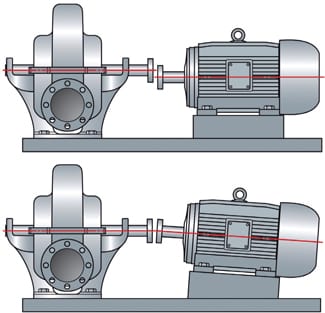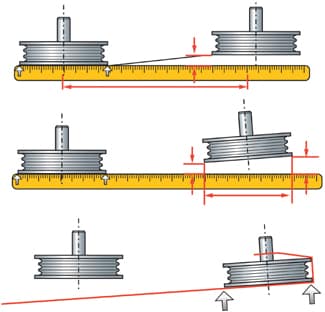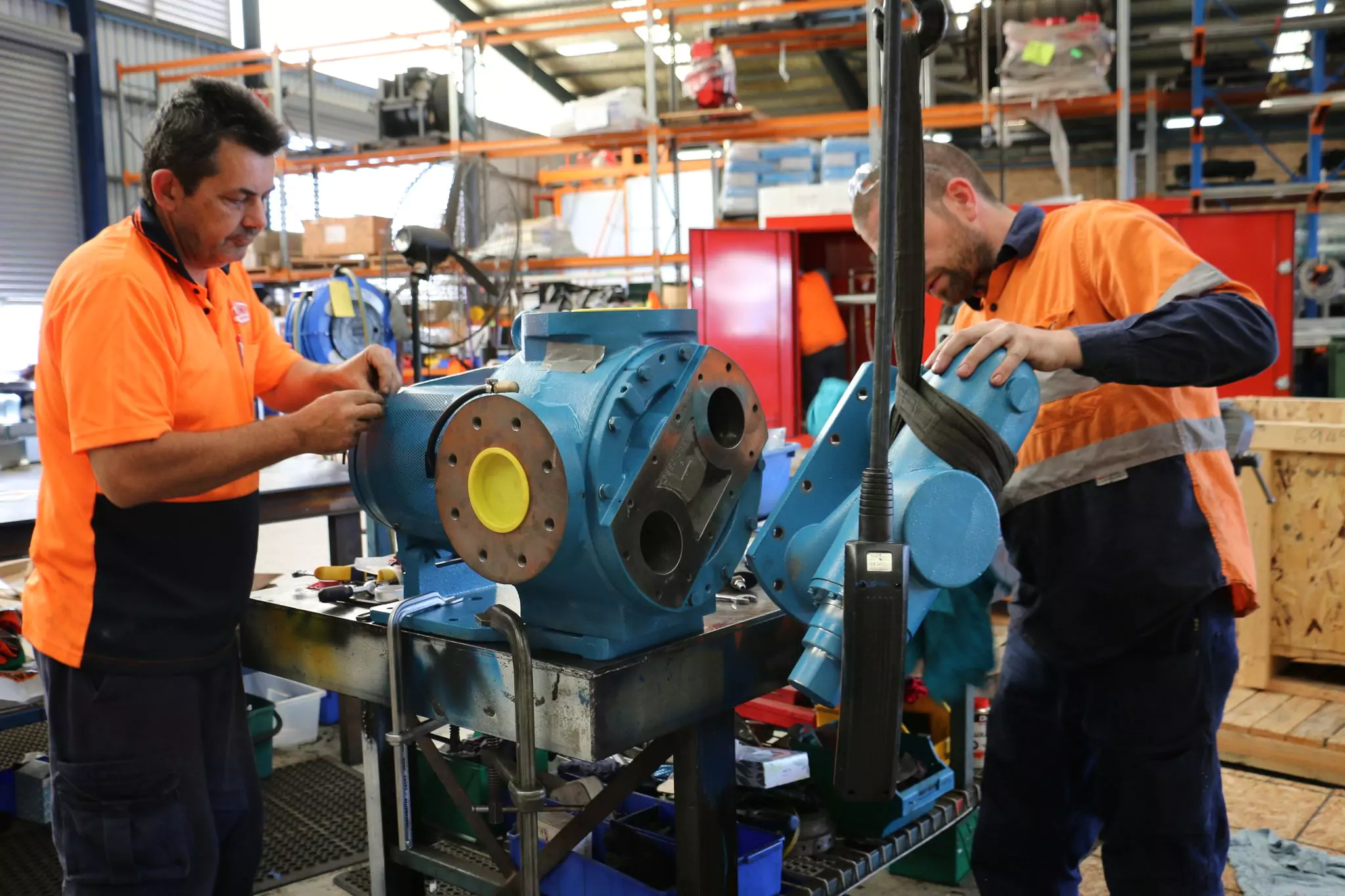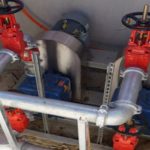Any equipment requires regular maintenance to keep it running smoothly. A pump that performs rigorous work every day needs scheduled inspections to ensure its settings, such as shaft or belt alignment, are kept within industry tolerances.
This blog will review the common misalignment issues in pumps and how they can be corrected.
WHAT IS PUMP ALIGNMENT?
Power is transmitted from a motor to a pump by connecting the motor and pump shafts. They can be directly connected using a straight shaft or joined together by a flexible coupling. In some systems, belts are also used between the motor and the pump or the motor and the coupling.
Misaligned shafts lead to costly and unplanned downtime. They also often result in damaged seals. Consequently, broken seals can cause lubrication problems and leaks.
Other potential problems caused by misalignment that can seriously impact a company’s bottom line include:
- Increased friction resulting in excessive wear, excessive energy consumption, and premature breakdown of equipment
- Excessive wear on bearings and seals, or belt and pulleys
- Premature shaft and coupling failure
- Excessive seal lubricant leakage
- Failure of coupling and foundation bolts
- Increased vibration and noise
- Reduced efficiency
Looking at these issues, shaft misalignment should be detected and corrected immediately. The stress that misalignment poses on pumps can trigger bigger problems than mere seal and coupling failure. In worst cases, unattended shaft misalignment can cause permanent damage to both the pump and motor, leading to a costly replacement.
SHAFT MISALIGNMENT

With the current challenge in reducing costs and optimising assets, the necessity of accurate shaft alignment has never been greater. Shaft misalignment is responsible for as much as 50 per cent of pump breakdown costs. Thus, by aligning shafts correctly, these costs can be reduced significantly, as well as unplanned downtimes resulting in production loss.

Types Of Shaft Misalignment
- Parallel misalignment can be categorised as horizontal or vertical.
Parallel horizontal misalignment happens when the motor shaft is moved horizontally away from the pump shaft, making the shafts parallel to each other in the horizontal plane. Meanwhile, parallel vertical misalignment occurs when the motor shaft is moved vertically away from the pump shaft, making the shafts parallel to each other in the vertical plane. - Angular misalignment is also categorised as either horizontal or vertical misalignment. Angular misalignment occurs when the motor shaft is at an angle with the pump shaft, but both shafts still operate in the same horizontal or vertical plane.
Correcting Shaft Misalignment
There are several ways to detect and correct improperly aligned shafts. The most common methods include:

- Traditional alignment methods include visual inspection and the use of a straightedge or ruler. The straightedge is positioned on two bearings supporting one or more shafts while the maintenance inspector visually assesses whether or not the components are correctly aligned. While such rough alignment methods have the advantage of being quick and relatively easy, they are also highly inaccurate.
- Dial indicators are also among the earliest alignment tools. They are more accurate than visual judgment and rulers but require a high level of technical skill to use properly. Furthermore, dial indicators do not provide real-time values that enable technicians to measure and attain correct alignment simultaneously. Dial indicators must be removed and reinstalled after each alignment adjustment. As a result, the process of obtaining critical measurements, such as feet and coupling values, can be time-consuming.
- Laser-guided tools are quick, accurate, easy to use, and require a single installation. They deliver higher accuracy than dial indicators and do not require special skills.
Laser alignment uses two sensors placed on two connected shafts. The sensors fire lasers and receive the other sensor's beam simultaneously. Comparing the laser beams reveals whether the shafts are aligned and within a specified tolerance.
A more advanced laser shaft alignment system comes with a built-in step-by-step alignment process, from preparation, inspection and evaluation through correction, reporting and analysis. Some models also offer a unique database to store data regarding visual inspections on oil leakage, oil level, foundation bolt status, and wear indications.
Laser-alignment methods represent a marked improvement over traditional methods. Laser-guided tools allow one to adjust shaft alignment faster and more accurately than the straightedge or dial method.
Belt or Pulley Misalignment
Indirect drives use gears or pulleys and belts or chains to offset the motor shaft from the pump shaft. In belt and pulley alignment, the grooves of the pulleys are placed in line with one another. Done correctly, there will be low risks of premature wear for the belt and energy loss for the pump or motor.

Types Of Belt Misalignment
As with shaft misalignment, there are various types of belt misalignment. The following illustrations show the three different types of belt misalignment.

1.Vertical angle or twisted misalignment occurs when one of the pulleys has an angular error from the vertical angle plane. This is usually caused by incorrect positioning of the pump. This problem can be corrected by lifting either the front or rear feet of the motor to which the pulley is attached, depending on the direction of the vertical angle error.
2.Horizontal angle misalignment occurs when the driver and the driven unit are not parallel to each other. Horizontal angle misalignment can be corrected by moving the front or rear feet forward or backward to their guides, depending on the direction of the horizontal angle error, to twist the motor around its centre.
3.Parallel misalignment is the least complex form of misalignment. It is often caused by the incorrect positioning of the motor along its shaft axis, positioned either too far forward or backward compared to the other shaft. Or it can be caused by incorrect positioning of the pulleys on their respective shaft, where one of the pulleys needs to be adjusted on the shaft.
Belt Alignment Methods
Like shaft alignment, belt alignment can be done by a traditional visual or laser alignment method. Traditional methods usually employ strings or straightedges. Laser methods utilise laser beams, which provide a much higher degree of accuracy.
Laser alignment tools on the market can be categorised according to how the devices are attached to the pulley and how they align. Generally, there are two groups - one that aligns the face of the pulleys and one that aligns the grooves.
Most laser alignment tools use the face or side of the pulley as a reference for aligning the pulleys and belts. The advantage of this method is that it can be used for belt types other than V-belts, such as timing belts. However, V-belts are the most commonly used type in industrial applications.
The main disadvantage is that the face of the pulley is the only reference point. This method results in varying degrees of accuracy when the pulleys are of different thickness, brands, kinds (e.g. one single-belt pulley and one multiple-belt pulley) or when the faces are not well finished.
Products that align using the grooves of the pulleys provide substantially higher levels of accuracy regardless of the thickness, brand or type of pulleys.
Common Causes of Misalignment
Shaft and belt misalignment can be a result of several factors such as:
- Soft foot is a condition in which one of the feet of a pump does not sit flat on the baseplate. Soft foot is among the most common causes of misalignment. To check, operators should first assess the equipment's foundation and employ a suitable shaft alignment tool to identify and correct potential soft foot conditions. Some laser-guided alignment tools have a soft foot operation capability that guides the operators through corrective procedures.
- Bearings out of square with their housings are another common cause of misalignment. Often a condition of wear, the out-of-square bearing and/or its housing will need to be corrected or replaced to bring pumps back into alignment.
Other possible causes include:
- Poor pump and motor alignment during instalment
- Worn out components
- Excessive forces generated by attachments
- Foot locator has moved or warped
- Thermal expansion
- Excessive forces and moments
Misalignment Indicators
Noise and vibrations are the first indications of a running pumping system problems. Vibration analysis, performed as part of a preventative maintenance and monitoring programme, can identify if shaft misalignment is becoming a problem. Rapid detection of misalignment in this way can save a pumping system from damage.
Maintaining Correct Alignment
Once shaft or belt misalignment is detected, analysed and corrected, an ongoing alignment maintenance program is important to keep operations running smoothly. As part of this maintenance, alignment checks should be performed to document alignment conditions before a machine is removed from service. This gives users the ability to install new or rebuilt machines with the same proper alignment values. In addition, a maintenance program should include periodic checks to verify conditions are still within tolerance.
Taking these simple steps to detect, correct and maintain proper shaft and belt alignment can prevent costly, unplanned downtime. Fortunately, there is a range of modern laser-alignment options available to make this process easier.
All-Pumps Laser Shaft Alignment Services
Reduce these breakdowns, production losses, high energy consumption, overheating, excessive vibration, and premature wear and tear with our laser alignment services.
All-Pumps have qualified experts well-positioned to perform laser alignment services using the latest SKF shaft alignment tools to achieve the highest accuracy. We also provide a detailed Laser Alignment Report for your reference after service completion.
We can work to fix:
- Incorrect shaft alignment
- Parallel misalignment (for offset)
- Angular misalignment
- Soft Footing of Base Plates and Old Equipment



